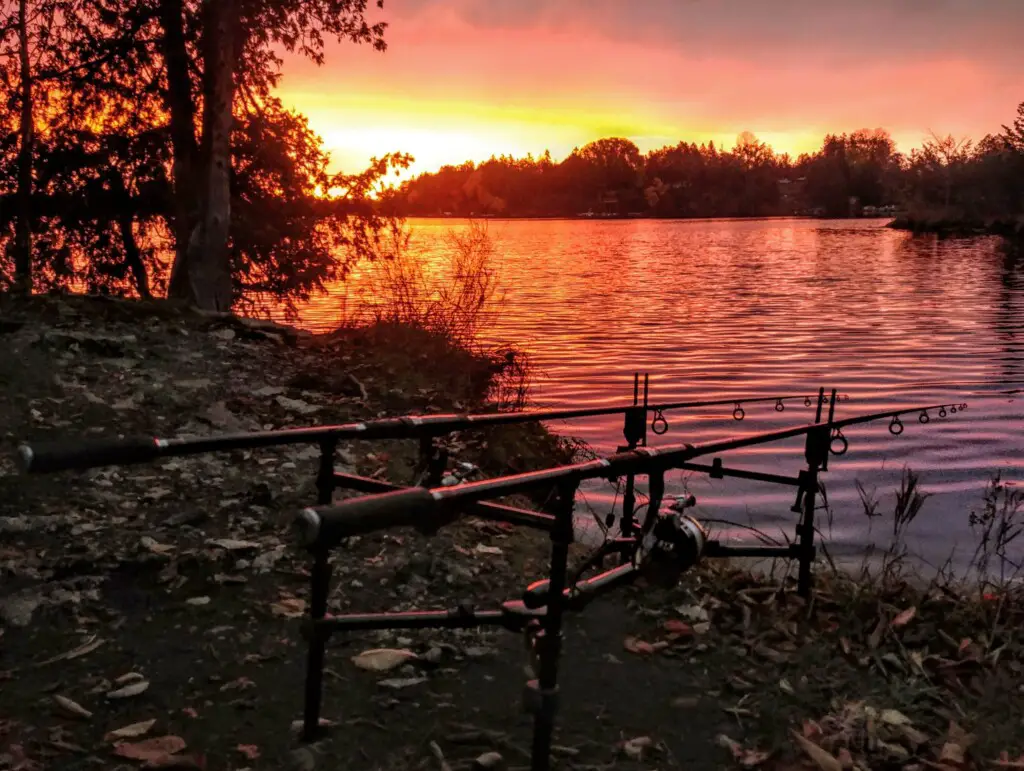With the incredibly exciting announcement of a three-rod regulation for the pursuit of Common Carp in Ontario, I amongst countless Ontarian Carp anglers are jubilant for this incredible opportunity. In all the excitement, I have already found myself contemplating multi-line fishing strategies for carp in what is possibly one of the most prolific fisheries in the world. Nevertheless, common sense needs to prevail in all of this, and I hope this guide will be helpful for you this season.
First and foremost, fish care must be a priority. Fishing with multiple lines is indeed an amazing opportunity for carp anglers here in Ontario, but we must be aware that with multiple lines comes the chance of having multiple fish on at a time, which under certain circumstances can lead to an array of dangerous complications. These include but are not limited to a fish becoming entangled in a snag because of not being turned around in time and/or the loss of tackle. Ideally, when fishing with multiple lines in our wild waters here in Ontario, the rule of thumb should be: if the action is hot, one rod in the right place is more than enough.
Now, the action is not always going to be hot, and in those moments having the second or third rod in the water might mean the difference between catching and blanking. Running three rods during the winter months would be an ideal way of locating fish when the bite is slow, and the fish are grouped tightly together. Finding the school in those cases is paramount to success and having three rods spread out in swim stacks the odds in your favor. Additionally, when fishing larger waters, fish naturally disperse, and staggering rods along the waterfront might be the difference between being on the fish or being well out of their range.
Personally, I see myself running two rods for 95% of the season, even vouching to drop down to one rod when the action is dynamite, or when conditions allow for the safe use of only one rod. Here are some of my strategies on how I intend to approach multi-line fishing this year.
The “Rover”

The transient, the rover, the sniper. Whatever you call a rod positioned near “showing” (breaching) fish, this strategy, which I am excited to employ, is exceptionally useful during those colder spring and fall months. When the water is cold, and fish are waking up or slowing down for the winter, the carp gather in great numbers, forming tightly knit pods. A breaching carp typically betrays the location of these pods.
Now, suppose, after having baited a swim for a few days, you arrive ready to fish at your swim, only to find that the carp are breaching further from shore than you had baited. This happened to me last year during my “Spring Campaign” where I found myself torn between keeping a rod on my baited swim or casting to the showing fish. I went with my gut at first and positioned my rod on the baited area. While I waited for a bite, I couldn’t help but note the number of fish showing at a distance away. This led me to believe that the fish were less confident feeding in close, and I pondered whether to move my rig. Thankfully, I was rewarded with a fish from the baited part of my swim. Whilst releasing that fish, I noticed a carp breach at a farther distance. (See 6:45 of the previously mentioned video.) Having just landed that first fish, the pressure was off, and so I decided to cast a rig roughly sixty yards out to where I had seen the last showing fish; twenty minutes later, I was graced by a stunning low twenty-pound common. Had I then the option of running two rods, I would have immediately cast to those showing fish, and likely would have caught more; I would have simply set up one rig on my baited area and introduced a second rig where I saw frequent showing/bubbling. This is a trusted technique in the UK, and one which I call the ‘rover method.’

Pro Tip: Do not shy away from frequently repositioning this rod. When applied correctly, it can be a highly effective way of nabbing that second bite and even tripping up weary, often bigger fish galumphing about at range.
The “Experimental One”
So, you have mastered the sweetcorn hair rig and feel uber-confident and ready to introduce that second identical rig into the same swim a few feet apart—but wait! If you are certain that such a rig and bait will work, why not try something new, perhaps in which you have less confidence? Getting ‘riggy’ with it and experimenting with baits in certain scenarios can be the difference between blanking and catching. On several occasions, I have simply changed my bait or rig, often to something completely new, and found it successful.

Many of us get lulled into a false sense of security when it comes to presenting carp rigs. We like to believe that some baits are universally and absolutely better than others. To some degree, this is true. But it is unlikely that one bait works better than all others in all possible circumstances.
Carp are a lot smarter than most people give them credit for, as my good friend Galen has observed time and time again, and they will often devour an entire pile of corn without so much as sniffing a boilie. (Be sure to check Galen’s Instagram account for incredible underwater footage of feeding carp @ontcarpn.) So why not, switch things up a bit? Why not tie up and toss out a pop-up rig or even something strange like a gummy bear (a vegan one, of course) on one rod to see how fish respond to this new offering? You might be surprised to find that they are more attracted to that second option, or the complete opposite in which case you still have a rod primed and ready with something you are confident in! Experimenting with different rigs and expanding our confidence in different baits can make us more rounded and prepared anglers for any challenge we might encounter.
The “Stalker”
Like the “Rover,” the stalking rod can be an effective way of introducing a rig right in the path of a feeding fish. The way in which it differs from the previously discussed method is simply the proximity of angler to fish. Typically, carp are “stalked” from the margins, which for all intents and purposes will be considered the first ten yards from shore. This is typically an area where an angler can see the fishes’ movements, feeding and patterns. This might lead an angler to try something that can be incredibly exhilarating: teasing a bite from some confidently feeding fish. This can be achieved with either a free-lined (no weight) presentation, under a stick float, or for the ultimate challenge, on the fly. Whilst stalking for carp in the margins one could present a rig at a distance over a bed of free offerings in an attempt to secure a feeding area far from shore. This is an effective tactic, since nearby fish tend to scatter and flee when one of their own is hooked. Providing another feeding area, away from where the fish’s pod-mate was just nabbed, might offer the carp a sense of security and confidence to continue feeding.

Now, back to the stalking business: this method can be incredibly painstaking and could take a great deal of practice to present a rig in just the right way that will entice, rather than startle, the carp. Stalking continues to be a favourite method of mine when fishing clear water. There is something incredibly exciting, albeit maddening, about watching a carp take your presentation right before your very eyes. Hold on tight!
The Short Line and Long Line Method

The name pretty much gives this method away: one rod positioned out far from shore, and the other(s) positioned closer in. This strategy allows you to cover more water and (similar to the stalking method) creates numerous feeding opportunities for carp as opposed to one giant bait pile, which can eventually lead to weary fish. I have previously applied this tactic when fishing with friends. Having two separate baited areas set a distance apart has a number of pros, namely, it helps locate where the fish are most confidently feeding and increases the chances of catching more fish, with a reduced chance of tangling up in one another’s lines.
Carp are typically very fond of the “margins” near shore, however, several factors, including the presence of anglers, can push them further from shore. When this happens, having a baited area at a distance can effectively intercept the fish in an area where they feel more confident. However, countless times I have observed fish swimming right along the margins within view after positioning my rig far from shore, often prompting the internal strife of whether to reposition that single rod. Once again, like the previously mentioned strategies, this is no longer necessary, as we now have the opportunity to explore these options! Having your rods spread out between shallow margins and deeper water could be the difference between catching a fish and not. Having the opportunity to cover more water is a new and welcome advantage for carp anglers in Ontario.
Spreading Out Method
Like the Short Line and Long Line Method, the Spreading Out method covers a larger area. However, it differs from other methods in that the rigs are positioned on the same “line” relative to shore. This method is particularly effective in rivers, as bait and free offerings in flowing water tend to fall in a stream-like pattern.
Thus, having rigs placed along this long line of free offerings is a particularly good idea. How far you might ask? Well, I have firsthand seen rods positioned WAY downriver from where free offerings have been introduced, and surprisingly they intercept fish that are on their way up to the baited swim. The reason is simple: the fish will follow food signals upriver (typically) and therefore will move upstream to feed on the offerings. It is possible to catch fish as they are moving up to the baited area by positioning a rig with a method/pva product to draw the attention of that one fish. This method could also work by offering a “falling back” fish a quick bite as they once again push upriver towards the larger deposit of tasty treats. On a lake, however, this method may look a great deal different. It may involve spreading rods along the shoreline, or on either side of a massive clearing in some weeds, or even a rod positioned at the mouth of a creek and one at a distance, with a good deposit of bait on both areas. Regardless of how you spread out your rods with this method, you increase the chance of encountering more fish from different pods.
If you want to see the “ultimate” in spreading out your rigs, check out the way Angelo and Pete did it on Rice Lake a few years ago in where Pete fished traditionally from the shore while Ang—believe it or not—had the rod pod set up on the front deck of his boat. That’s a spread!

Whatever methods you employ in your angling this year, I ask once again that you prioritize above all else the safety of the fish. This means safe rigs, proper fish care equipment such as landing mats, carp nets, etc., and fishing a safe number of rods for the scenario. For example, opting for one rod in a particularly snaggy swim, or when the action is super-hot.
Tight lines, and let common sense prevail!








